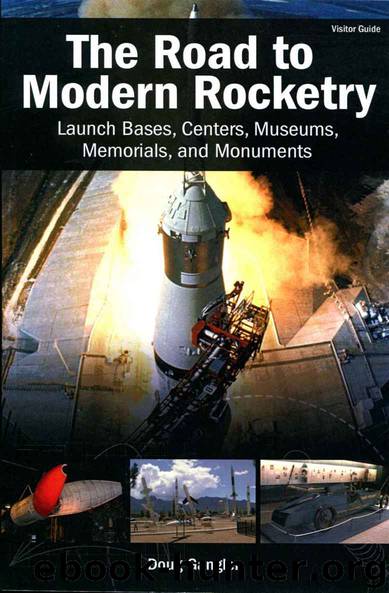The Road to Modern Rocketry: Launch Bases, Centers, Museums, Memorials, and Monuments by Doug Gangler

Author:Doug Gangler [Gangler, Doug]
Language: eng
Format: epub
Publisher: Champion Books
Published: 2016-03-29T22:00:00+00:00
Section 5.2: Other Early U.S. Rocket Efforts
In the 1930s, advancement of rocketry in the United States was not just in the domain of Robert Goddard. It is true that official government interest and support of rocketry were at very low levels prior to the Second World War; efforts were nowhere near those of Germany, or even of the Soviet Union. The main amateur group doing launches was the American Rocket Society (ARS), officially founded in 1930 in New York as the American Interplanetary Society (the name change to ARS coming in 1934) by G. Edward Pendray and fellow enthusiasts.
In 1931, Pendray and his wife visited the Verein für Raumschiffahrt (Society for Space Travel) in Germany as official representatives of the budding American organization. Pendray shared information, took copious notes, and returned home with some initial rocket designs.
Goddard did not at first join the group; he would in time take membership. ARS members actually became quite irritated with Goddard, as he generally shared very little of his work due to his penchant for secrecy.
Members conducted liquid-propellant experiments in rural New Jersey and New York, before turning to solids later in the 1930s. Their first rocket launch was in May 1933 on Staten Island, with the rocket exploding after two seconds at an altitude of 250 feet (76 m). But it was considered a success in that experience had been gained. In September 1934, Rocket No. 4 climbed to an altitude of 382 feet (116 m), had a range of 1,338 feet (408 m), and a velocity of over 600 miles per hour (966 kph).
In 1936, member Alfred Aricano won the REP-Hirsch Prize for the design of a high-altitude rocket. The resulting publicity boosted membership and established the ARS as a leader in amateur rocketry for the period. In the 1950s, membership would grow rapidly to 21,000 as rocket technology and astronautics boomed. In early 1963, the ARS merged with an aero-organization to become the American Institute of Aeronautics and Astronautics.
Download
This site does not store any files on its server. We only index and link to content provided by other sites. Please contact the content providers to delete copyright contents if any and email us, we'll remove relevant links or contents immediately.
| Aeronautics & Astronautics | Astronomy |
| Astrophysics & Space Science | Comets, Meteors & Asteroids |
| Cosmology | Mars |
| Solar System | Star-Gazing |
| Telescopes | UFOs |
Tools of Titans by Timothy Ferriss(8219)
Turbulence by E. J. Noyes(7937)
Secrets of Antigravity Propulsion: Tesla, UFOs, and Classified Aerospace Technology by Ph.D. Paul A. Laviolette(5309)
Astrophysics for People in a Hurry by Neil DeGrasse Tyson(5134)
Room 212 by Kate Stewart(5040)
Design of Trajectory Optimization Approach for Space Maneuver Vehicle Skip Entry Problems by Runqi Chai & Al Savvaris & Antonios Tsourdos & Senchun Chai(5011)
Pale Blue Dot by Carl Sagan(4913)
The David Icke Guide to the Global Conspiracy (and how to end it) by David Icke(4628)
A Journey Through Divination and Astronomy by Publishing Pottermore(4344)
Goodbye Paradise(3728)
Apollo 8 by Jeffrey Kluger(3637)
COSMOS by Carl Sagan(3554)
Losing the Nobel Prize by Brian Keating(3499)
The Five People You Meet in Heaven by Mitch Albom(3475)
How to Read Water: Clues and Patterns from Puddles to the Sea (Natural Navigation) by Tristan Gooley(3409)
Brief Answers to the Big Questions by Stephen Hawking(3369)
How to Read Nature by Tristan Gooley(3249)
The Order of Time by Carlo Rovelli(3145)
A Brief History of Time by Stephen Hawking(2962)
